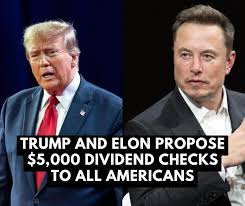A new proposal backed by President Donald Trump and billionaire Elon Musk is making waves: issuing “DOGE dividends” to American taxpayers. The idea, originally conceived by 30-year-old investor James Fishback, suggests distributing government savings as direct payments to taxpaying households. However, low-income Americans may not qualify for these benefits.

The Birth of the Idea
Fishback, CEO of investment firm Azoria, said the concept came to him in a dream. Upon waking, he collaborated with his firm’s lead researcher to draft a proposal that quickly gained traction. He shared it with key figures in the administration, including White House Chief of Staff Susie Wiles. Soon after, Musk acknowledged the idea on X (formerly Twitter) and promised to bring it to Trump’s attention.
By Wednesday, Trump publicly supported the proposal at the FII Priority Summit in Miami Beach. He suggested using 20% of the savings generated by Musk’s Department of Government Efficiency (DOGE) to fund these dividends while using another 20% to reduce national debt.
Who Would Get the Checks?
Unlike past stimulus payments, which were distributed broadly, Fishback’s plan limits eligibility to “net-income taxpayers”—households that pay more in taxes than they receive in government benefits. According to the Pew Research Center, many Americans earning under $40,000 pay little to no federal income tax, making them ineligible for the proposed DOGE dividends.
Fishback estimates that DOGE will generate $2 trillion in government savings. Under his plan, 20% of these savings ($400 billion) would be distributed among 79 million qualifying households, resulting in payments of approximately $5,000 each.
Inflation Concerns and Economic Impact
Fishback argues that since these payments would come from existing government savings rather than deficit spending, they wouldn’t contribute to inflation. He contrasts them with pandemic-era stimulus checks, which were distributed more widely and often spent immediately. He believes that higher-income households are more likely to save the dividends, reducing the risk of inflation.
Despite Fishback’s confidence, some experts remain skeptical. Mark Zandi, chief economist at Moody’s Analytics, cautioned that the plan hinges on DOGE’s ability to generate massive government savings, which remains uncertain. DOGE has claimed $55 billion in savings so far, but some of its figures have been questioned. For example, the group previously reported saving $8 billion by canceling a Department of Homeland Security contract that was actually worth only $8 million.
Political and Economic Reactions
House Speaker Mike Johnson was lukewarm on the idea, citing concerns about fiscal responsibility given the $36 trillion national debt. While acknowledging that handing out checks could be politically popular, he emphasized the need to focus on reducing the deficit.
Musk, however, remains optimistic. Speaking at the Conservative Political Action Conference (CPAC), he claimed Trump is fully on board with the plan.
The Uncertain Future of DOGE Dividends
Fishback has been actively discussing the proposal with policymakers in Washington, though details remain unclear. He insists that even if DOGE savings fall short of the projected $2 trillion, smaller dividend payments would still provide meaningful financial relief.
Critics argue that large-scale government cuts come with economic consequences, including job losses that could offset any financial gains. Zandi warned against assuming that all government jobs eliminated by DOGE are unnecessary, noting that agencies like the FAA and FDA play crucial roles in national stability and economic health.
While the idea of DOGE dividends has gained significant attention, it remains to be seen whether Trump, Musk, and their allies can turn this ambitious proposal into reality.
